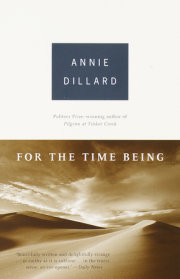I have in my hands the standard manual of human birth defects.
Smith's Recognizable Patterns of Human Malformation, fourth edition, by Kenneth Lyons Jones, M.D., professor of pediatrics at UC-San Diego, 1988, is a volume to which, in conscience, I cannot recommend your prolonged attention. In vivid photographs, it depicts many variations in our human array.
This photograph shows, for example, the bird-headed dwarfs. They are a brother and sister; they sit side by side on a bed. The boy, a blond, is six years old, says the caption, and the girl, brown-haired, is three. Indeed their smooth bodies and clear faces make them look, at first and second glances, to be six and three years old. Both are naked. They have drawn their legs up to their chests. The camera looks down on them. The girl has a supercilious expression, and seems to be looking down her nose at the camera. Bright children often show this amused and haughty awareness: "And who might you be, Bub?"
The girl's nose is large, her eyes are large, her forehead recedes a bit, and her jaw is small. Her limbs are thin but not scrawny. Her thoughtful big brother looks quite like her. His nose is big. His eyes are enormous. He gazes off to the side, as if wishing he were somewhere else, or reflecting that this camera session will be over soon. His blond hair, cut rather Frenchily in layers, looks ruffled from playing.
"Friendly and pleasant," the text says of bird-headed dwarfs; they suffer "moderate to severe mental deficiency." That is, the bird-headed dwarf girl whose face I read as showing amused and haughty awareness may, I hope, have been both aware and amused in her life, but she was likely neither haughty nor bright. The cerebrums of both the boy and the girl are faulty. The cerebrum shows a "simple primitive convolutional pattern resembling that of a chimpanzee." They have only eleven pairs of ribs apiece; they cannot straighten their legs; like many bird-headed dwarfs, they have displaced hips. Others have displaced elbows. "Easily distracted," the text says.
The stunning thing is the doctor's hand, which you notice at third glance: It shows the children in scale. The doctor's hand props the boy up by cupping his shoulders--both his shoulders--from behind. The six-year-old's back, no longer than the doctor's open hand, is only slightly wider than a deck of cards. The children's faces are the length of the doctor's thumb. These people have, as a lifelong symptom, "severe short stature." The boy is the size of an eleven-month-old infant; the girl is the size of a four-month-old infant. If they live and grow, and get their hips fixed, they can expect to reach a height of about three feet. One bird-headed dwarf lived to be seventy-five years old, no taller than a yardstick.
And friendly and pleasant, but easily distracted. There is a lot to be said for children who are friendly and pleasant. And you--are you easily distracted yourself, these days?
If your child were a bird-headed dwarf, mentally deficient, you could carry him everywhere. The bird-headed dwarfs and all the babies in Smith's manual have souls, and they all can--and do--receive love and give love. If you gave birth to two bird-headed dwarfs, as these children's mother did--a boy and a girl--you could carry them both everywhere, all their lives, in your arms or in a basket, and they would never leave you, not even to go to college.
The Talmud specifies a certain blessing a man says when he sees a person deformed from birth. All the Talmudic blessings begin "Blessed art Thou, O Lord, our God, King of the Universe, who . . .". The blessing for this occasion, upon seeing a hunchback or a midget or anyone else deformed from birth, is "Blessed art Thou, O Lord, our God, King of the Universe, WHO CHANGES THE CREATURES."
A chromosome crosses or a segment snaps, in the egg or the sperm, and all sorts of people result. You cannot turn a page in Smith's Recognizable Patterns of Human Malformation [[ital]] without your heart pounding from simple terror. You cannot brace yourself. Will this peculiar baby live? What do you hope? The writer calls the paragraph describing each defect's effects, treatment, and prognosis "Natural History." Here is a little girl about two years old. She is wearing a dress with a polka-dot collar. The two sides of her face do not meet normally. Her eyes are far apart, and under each one is a nostril. She has no nose at all, only a no-man's-land of featureless flesh and skin, an inch or two wide, that roughly bridges her face's halves. You pray that this grotesque-looking child is mentally deficient as well. But she is not. "Normal intelligence," the text says.
Of some vividly disfigured infants and children--of the girl who has long hair on her cheeks and almost no lower jaw, of the three-fingered boy whose lower eyelids look as if he is pulling them down to scare someone, of the girl who has a webbed neck and elbows, "rocker-bottom" feet, "sad, fixed features," and no chin--the text says, "Intelligence normal. Cosmetic surgery recommended."
Turn the page. What could cosmetic surgery do for these two little boys? Their enormous foreheads bulge like those of cartoon aliens; their noses are tiny and pinched, the size of rose thorns; and they lack brows, lashes, and chins. "Normal intelligence."
Of God, the kabbalah asserts: Out of that which is not, He made that which is. He carved great columns from the impalpable ether.
Here is one fine smiling infant. Why is a fine smiling infant pictured in this manual? You must read it. The infant does indeed present the glad sight of a newborn baby, but it will develop oddly. Note the tight fist--the expert in the manual points it out to the attending pediatrician--and observe the tiny pit in the skin just before the ear, or the loose skin at the back of the neck. Observe the "thin sparse hair," "small nose," and subtly small fingernails. What baby, you cry, lacks these features?
These particular babies look normal, or very, very close to normal--close, but no cigar. "Average IQ 50," the text says, or "30." Of Hurler syndrome babies, who are very short, with claw hands, cloudy corneas, short necks, and coarse features: "These patients are usually placid . . . and often loveable. Death usually occurs in childhood."
According to Inuit culture in Greenland, a person possesses six or seven souls. The souls take the form of tiny people scattered throughout the body.
Do you suffer what a French paleontologist called "the distress that makes human wills founder daily under the crushing number of living things and stars"? For the world is as glorious as ever, and exalting, but for credibility's sake let's start with the bad news.
An infant is a pucker of the earth's thin skin; so are we. We arise like budding yeasts and break off; we forget our beginnings. A mammal swells and circles and lays him down. You and I have finished swelling; our circling periods are playing out, but we can still leave footprints in a trail whose end we do know.
Buddhism notes that it is always a mistake to think your soul can go it alone.
Copyright © 2000 by Annie Dillard. All rights reserved. No part of this excerpt may be reproduced or reprinted without permission in writing from the publisher.



